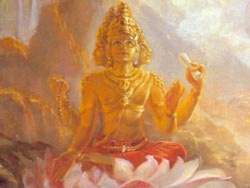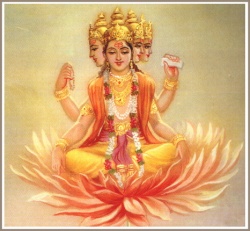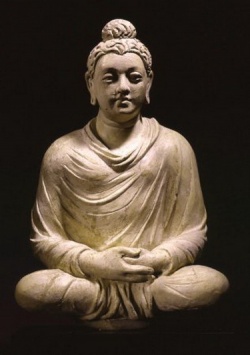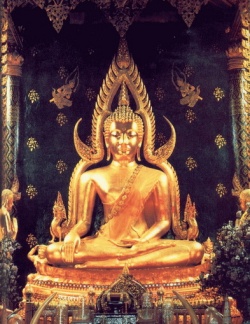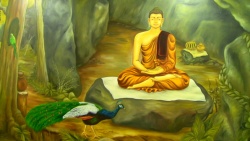Difference between revisions of "Brahmā (Buddhism)"
(Created page with "Brahmā in Buddhism is the name for a type of exalted passionless deity (deva), of which there are several in Buddhist cosmology. Especially the mahayana Lotus sutra, chapter ...") |
m (Text replacement - "1" to "1") |
||
| (6 intermediate revisions by 2 users not shown) | |||
| Line 1: | Line 1: | ||
| − | Brahmā in Buddhism is the name for a type of exalted passionless deity (deva), of which there are several in Buddhist cosmology. Especially the mahayana Lotus sutra, chapter 7 makes mention of several "Brahma gods". | + | [[File:Brahma6.jpg|thumb|250px|]] |
| + | [[Brahmā]] in [[Buddhism]] is the [[name]] for a type of [[exalted]] {{Wiki|passionless}} [[deity]] ([[deva]]), of which there are several in [[Buddhist cosmology]]. Especially the [[mahayana]] [[Lotus sutra]], [[chapter]] 7 makes mention of several "[[Brahma]] [[gods]]". | ||
==Origins== | ==Origins== | ||
| − | The name Brahmā originates in Vedic tradition, in which Brahmā appears as the creator of the universe. By contrast, early Buddhist texts describe several different Brahmās coexisting in the same universe; some of them think they are "all powerful" creators of the world, but they are corrected by the Buddha. The myths, characters, and functions of these Brahmās are distinct from those of the Vedic Brahmā. However, at least one of the Buddhist Brahmās is identified as being the object of worship of pre-Buddhist brahmins. The Buddha described the Vedic Brahmā as a misunderstanding, or mistaken remembrance, of one or more of the Buddhist Brahmās, as explained in the Brahmajāla-sutta (Digha Nikaya 1). | + | The [[name]] [[Brahmā]] originates in {{Wiki|Vedic}} [[tradition]], in which [[Brahmā]] appears as the [[creator of the universe]]. By contrast, early [[Buddhist texts]] describe several different [[Brahmās]] coexisting in the same [[universe]]; some of them think they are "all powerful" creators of the [[world]], but they are corrected by the [[Buddha]]. The [[myths]], characters, and functions of these [[Brahmās]] are {{Wiki|distinct}} from those of the {{Wiki|Vedic}} [[Brahmā]]. However, at least one of the [[Buddhist]] [[Brahmās]] is identified as [[being]] [[the object]] of {{Wiki|worship}} of pre-Buddhist [[brahmins]]. The [[Buddha]] described the {{Wiki|Vedic}} [[Brahmā]] as a {{Wiki|misunderstanding}}, or mistaken [[remembrance]], of one or more of the [[Buddhist]] [[Brahmās]], as explained in the [[Brahmajāla-sutta]] ([[Digha Nikaya]] 1). |
| − | There is no identity between the Buddhist Brahmās and the Hindu conception of brahman as an all-encompassing divine force. | + | There is no [[Wikipedia:Identity (social science)|identity]] between the [[Buddhist]] [[Brahmās]] and the [[Hindu]] {{Wiki|conception}} of [[brahman]] as an all-encompassing [[divine]] force. |
| − | ==Classification== | + | =={{Wiki|Classification}}== |
| − | There are at least four ways of interpreting the term Brahmā (Japanese: 梵天 Bonten). It may refer to: | + | There are at least [[four ways]] of interpreting the term [[Brahmā]] ([[Japanese]]: [[梵天]] [[Bonten]]). It may refer to: |
| − | ::#Any of the deities of the Ārūpyadhātu or of the Rūpadhātu | + | ::#Any of the [[deities]] of the [[Ārūpyadhātu]] or of the [[Rūpadhātu]] |
| − | ::#Any of the deities of the nine lowest worlds of the Rūpadhātu, from Śubhakṛtsna to Brahmapāriṣadya. | + | ::#Any of the [[deities]] of the nine lowest [[worlds]] of the [[Rūpadhātu]], from [[Śubhakṛtsna]] to [[Brahmapāriṣadya]]. |
| − | ::#Any of the deities of the three lowest worlds of the Rūpadhātu | + | ::#Any of the [[deities]] of the three lowest [[worlds]] of the [[Rūpadhātu]] |
| − | ::#A Mahābrahmā, one of the highest deities of preceding group. | + | ::#A [[Mahābrahmā]], one of the [[highest]] [[deities]] of preceding group. |
| + | [[File:Brahma75.JPG|thumb|250px|]] | ||
| + | In the [[sense]] of "a [[being]] of the [[Rūpadhātu]]", the term [[Brahmā]] may be related to [[Brahmavihāra]], a term referring to the [[meditative]] states achieved through the four [[Rūpajhānas]], which are shared by the inhabitants of the [[Rūpadhātu]]. | ||
| + | =={{Wiki|Individual}} [[Brahmās]]== | ||
| − | In the | + | Several [[Brahmās]] are named in the [[Buddhist texts]]. In [[light]] of the [[ambiguity]] of the term "[[Brahmā]]", there is often some uncertainty about how to place these {{Wiki|individuals}} within the [[cosmological]] context. In terms of the texts where they appear, they either are presented as figures of authority or as characters with an [[exaggerated sense]] of their [[own]] importance. |
| − | == | + | ==[[Baka Brahmā]]== |
| − | + | [[Baka Brahmā]] (literally "[[crane-Brahmā]]") appears in the [[Majjhima Nikaya]], where he is a [[deity]] who believes that his [[world]] is [[permanent]] and without [[decay]] (and that therefore he is [[immortal]]), and that therefore there are no higher [[worlds]] than his. The [[Buddha]] refutes [[Baka's]] claims, relating the {{Wiki|concept}} of [[anitya]] or [[impermanence]], but one of [[Baka's]] attendants (influenced by [[Māra]]) asserts that [[Baka]] is the Creator, that those who praise him will be rewarded, but those who deny his [[powers]] will be terribly punished. The [[Buddha]] identifies the real speaker as [[Māra]], and states that he is free of his [[power]]. | |
| − | |||
| − | Baka | + | [[Baka]] then states that it is futile to escape his domain (which he imagines to be [[universal]]), and points out that if the [[Buddha]] depends upon any of the things within [[Baka's]] cognizance, he will be within his [[realm]], and [[Baka]] can act upon him as he sees fit. The [[Buddha]] responds that [[Baka]] does have this much [[power]], but that there are [[realms]] which [[Baka]] [[knows]] [[nothing]] of, and that the [[Buddha's]] [[knowledge]] places him [[beyond]] [[Baka's]] [[power]]. [[Baka]] is at last convinced by a display of the [[Buddha's]] {{Wiki|superior}} [[magical]] [[power]] and his ability to explain his {{Wiki|present}} situation by reference to his [[past lives]]. |
| + | [[File:Buddhagod1.jpg|thumb|250px|]] | ||
| + | [[Baka]] was in a [[past life]] a [[human]] [[ascetic]] named [[Kesava]]; by various means he saved many [[people]] from destruction. For his [[meditative]] prowess he was born as a [[Bṛhatphala deva]], and in successive [[rebirths]] gradually sank through the levels of the [[Rūpadhātu]] until he became an ordinary [[Brahmā]]. | ||
| − | Baka | + | On another [[occasion]], [[Baka]] believes that no [[monk]] or [[ascetic]] can enter his [[world]] (through [[supramundane]] [[powers]] of [[manifestation]]), but the [[Buddha]] himself and several of his [[disciples]] visit him to prove him wrong. |
| − | Baka | + | [[Baka Brahma]] appears in the [[Bakabrahma-sutta]] and the [[Brahmanimantanika-sutta]]. |
| + | ==[[Brahmā Sahampati]]== | ||
| − | + | [[Brahmā Sahampati]], said to be the most senior of the [[Mahābrahmās]], was the [[deity]] who invisibly attended on the [[Buddha]] when he [[attained]] [[enlightenment]], and when the [[Buddha]] was [[meditating]] at [[Uruvelā]] afterwards, encouraged him [[to teach the Dharma]] to [[humans]]. According to some commentaries he was an [[anagami]] ([[non-returner]]), one of the [[Śuddhāvāsa]] ([[Pure Abodes]]) [[deities]]. He was the [[rebirth]] of a [[monk]] named [[Sahaka]], who had been in the [[Saṅgha]] of [[Kāśyapa Buddha]]. | |
| − | + | On one [[occasion]], he encouraged a woman whose son was a [[bhikṣu]] not to make [[offerings]] to [[Brahmā]], but instead to give [[alms]] to her son (who coincidentally was named [[Brahmadeva]]). | |
| − | |||
| − | Brahmā Sahampati, | + | The [[Saṃyutta Nikāya]] contains verses said to have been spoken by [[Brahmā Sahampati]], when he, together with [[Śakra]], attended on the [[Buddha]]. He also attended upon the [[Buddha]] at his [[death]], and verses attributed to him are included in the [[Mahāparinibbāna-sutta]]. |
| + | [[File:Golenbuddha.JPG|thumb|250px|]] | ||
| + | Of all the [[Brahmās]] he seems to have been the closest to the [[Buddha]]. | ||
| + | ==[[Brahmā Sanatkumāra]]== | ||
| − | + | [[Brahmā Sanatkumāra]] ([[Sanskrit]]) or [[Brahmā Sanaṅkumāra]] ([[Pāli]]), the "Ever-young", appears in the [[Janavasabha-sutta]] (DN.18), where he is recalled as having created an [[illusionary]] presence to make himself perceptible to the coarser [[senses]] of [[Śakra]] and the [[gods]] of [[Trāyastriṃśa]]. He addressed these [[deities]], in such a way that each of them [[thought]] that he was [[being]] spoken to alone, and advised them to follow the [[precepts]] and practices of the [[Buddha]], and explained the good results that would come from such [[practice]]. | |
| − | + | Commentators explained the [[epithet]] of "Ever-young" by saying that he had chosen the [[appearance]] of a very young man, whose [[hair]] was still tied up in the adolescent style of five knots. | |
| − | + | ==[[Mahābrahmā]]== | |
| − | == | + | [[File:IMG 0345.jpg|thumb|250px|]] |
| + | The [[name]] [[Mahābrahmā]], more of a title than a [[name]], appears in several [[suttas]]. It properly belongs to the [[deity]] or [[deities]] of the [[third world]] of the [[Rūpadhātu]], but may be used for even higher [[deities]]. A [[Mahābrahmā's]] titles are: "[[Brahmā]], [[Great Brahmā]], the Conqueror, the Unconquered, the All-Seeing, All-Powerful, the [[Lord]], the Maker and Creator, the [[Ruler]], Appointer and Orderer, Father of All That Have Been and Shall Be." According to the [[Brahmajāla Sutta]] (DN.1), a [[Mahābrahmā]] is a [[being]] from the [[Ābhāsvara]] [[worlds]] who falls into a lower [[world]] through exhaustion of his [[merits]] and is [[reborn]] alone in the [[Brahma-world]]; {{Wiki|forgetting}} his former [[existence]], he imagines himself to have come into [[existence]] without [[cause]]. [[Beings]] who have been [[reborn]] from his [[world]] into the [[human world]] and are able to gain a [[memory]] of it, believe him to be the creator of the [[world]]. In the [[Kevaddha-sutta]] (DN.11), a [[Mahābrahmā]] is unable to answer a [[philosophical]] question addressed to him by a [[monk]], but conceals this fact from the [[devas]] of his retinue so as not to lose face in front of them. Addressing that [[monk]] privately, he tells him to ask his question of the [[Buddha]]. | ||
| + | ==[[Non-Buddhist]] [[views]] refuted in early texts== | ||
| − | + | The old [[Wikipedia:Upanishads|Upanishads]] largely consider [[Brahman]] in the {{Wiki|masculine}} [[gender]] ([[Brahmā]] in the {{Wiki|nominative}} case, henceforth "[[Brahmā]]") to be a personal [[god]], and [[Brahman]] in the neuter [[gender]] ([[Brahma]] in the {{Wiki|nominative}} case, henceforth "[[Brahman]]") to be the {{Wiki|impersonal}} [[world]] [[principle]]. They do not strictly distinguish between the two, however. The old [[Wikipedia:Upanishads|Upanishads]] ascribe these [[characteristics]] to [[Brahmā]]: first, he has [[light]] and luster as his marks; second, he is {{Wiki|invisible}}; third, he is unknowable, and it is impossible to know his [[nature]]; fourth, he is [[omniscient]]. The old [[Wikipedia:Upanishads|Upanishads]] ascribe these [[characteristics]] to [[Brahman]] as well. In the [[Buddhist texts]], there are many [[Brahmās]]. There they [[form]] a class of superhuman [[beings]], and [[rebirth]] into the [[realm]] of [[Brahmās]] is possible by pursuing [[Buddhist practices]]. In the early texts, the [[Buddha]] gives arguments to refute the [[existence]] of a creator. | |
| − | + | In the [[Pāli scriptures]], the neuter [[Brahman]] does not appear (though the [[word]] [[brahma]] is standardly used in [[compound]] words to mean "best", or "supreme"), however [[ideas]] are mentioned as held by various [[Brahmins]] in connection with [[Brahmā]] that match exactly with the {{Wiki|concept}} of [[Brahman]] in the [[Wikipedia:Upanishads|Upanishads]]. [[Brahmins]] who appear in the [[Tevijja-suttanta]] of the [[Digha Nikaya]] regard "union with [[Brahmā]]" as [[liberation]], and earnestly seek it. In that text, [[Brahmins]] of the [[time]] are reported to assert: "Truly every [[Brahmin]] versed in the three [[Vedas]] has said thus: 'We shall expound the [[path]] for the sake of union with that which we do not know and do not see. This is the correct [[path]]. This [[path]] is the [[truth]], and leads to [[liberation]]. If one practices it, he shall be able to enter into association with [[Brahmā]]." The early [[Wikipedia:Upanishads|Upanishads]] frequently expound "association with [[Brahmā]]", and "that which we do not know and do not see" matches exactly with the early [[Upanishadic]] [[Brahman]]. | |
| − | + | In the earliest [[Upanishad]], the [[Brihadaranyaka Upanishad]], the [[Absolute]], which came to be referred to as [[Brahman]], is referred to as "the imperishable". The [[Pāli scriptures]] {{Wiki|present}} a "[[pernicious]] view" that is set up as an [[absolute]] [[principle]] corresponding to [[Brahman]]: "O [[Bhikkhus]]! At that [[time]] [[Baka]], the [[Brahmā]], produced the following [[pernicious]] view: 'It is [[permanent]]. It is [[eternal]]. It is always [[existent]]. It is {{Wiki|independent}} [[existence]]. It has the [[dharma]] of non-perishing. Truly it is not born, does not become old, does not [[die]], does not disappear, and is not born again. Furthermore, no [[liberation]] {{Wiki|superior}} to it [[exists]] elsewhere." The [[principle]] expounded here corresponds to the {{Wiki|concept}} of [[Brahman]] laid out in the [[Wikipedia:Upanishads|Upanishads]]. According to this text the [[Buddha]] criticized this notion: "Truly the [[Baka Brahmā]] is covered with unwisdom." | |
| − | The | + | The [[Buddha]] confined himself to what is [[empirically]] given. This {{Wiki|empiricism}} is based broadly on both ordinary [[sense]] [[experience]] and extrasensory [[perception]] enabled by high degrees of [[mental concentration]]. |
| − | |||
| − | |||
| − | |||
| − | |||
| − | |||
| − | |||
| − | |||
| − | |||
| − | |||
{{W}} | {{W}} | ||
| − | Category: | + | |
| + | [[Category:Deities]] | ||
Latest revision as of 22:12, 26 October 2015
Brahmā in Buddhism is the name for a type of exalted passionless deity (deva), of which there are several in Buddhist cosmology. Especially the mahayana Lotus sutra, chapter 7 makes mention of several "Brahma gods".
Origins
The name Brahmā originates in Vedic tradition, in which Brahmā appears as the creator of the universe. By contrast, early Buddhist texts describe several different Brahmās coexisting in the same universe; some of them think they are "all powerful" creators of the world, but they are corrected by the Buddha. The myths, characters, and functions of these Brahmās are distinct from those of the Vedic Brahmā. However, at least one of the Buddhist Brahmās is identified as being the object of worship of pre-Buddhist brahmins. The Buddha described the Vedic Brahmā as a misunderstanding, or mistaken remembrance, of one or more of the Buddhist Brahmās, as explained in the Brahmajāla-sutta (Digha Nikaya 1).
There is no identity between the Buddhist Brahmās and the Hindu conception of brahman as an all-encompassing divine force.
Classification
There are at least four ways of interpreting the term Brahmā (Japanese: 梵天 Bonten). It may refer to:
- Any of the deities of the Ārūpyadhātu or of the Rūpadhātu
- Any of the deities of the nine lowest worlds of the Rūpadhātu, from Śubhakṛtsna to Brahmapāriṣadya.
- Any of the deities of the three lowest worlds of the Rūpadhātu
- A Mahābrahmā, one of the highest deities of preceding group.
In the sense of "a being of the Rūpadhātu", the term Brahmā may be related to Brahmavihāra, a term referring to the meditative states achieved through the four Rūpajhānas, which are shared by the inhabitants of the Rūpadhātu.
Individual Brahmās
Several Brahmās are named in the Buddhist texts. In light of the ambiguity of the term "Brahmā", there is often some uncertainty about how to place these individuals within the cosmological context. In terms of the texts where they appear, they either are presented as figures of authority or as characters with an exaggerated sense of their own importance.
Baka Brahmā
Baka Brahmā (literally "crane-Brahmā") appears in the Majjhima Nikaya, where he is a deity who believes that his world is permanent and without decay (and that therefore he is immortal), and that therefore there are no higher worlds than his. The Buddha refutes Baka's claims, relating the concept of anitya or impermanence, but one of Baka's attendants (influenced by Māra) asserts that Baka is the Creator, that those who praise him will be rewarded, but those who deny his powers will be terribly punished. The Buddha identifies the real speaker as Māra, and states that he is free of his power.
Baka then states that it is futile to escape his domain (which he imagines to be universal), and points out that if the Buddha depends upon any of the things within Baka's cognizance, he will be within his realm, and Baka can act upon him as he sees fit. The Buddha responds that Baka does have this much power, but that there are realms which Baka knows nothing of, and that the Buddha's knowledge places him beyond Baka's power. Baka is at last convinced by a display of the Buddha's superior magical power and his ability to explain his present situation by reference to his past lives.
Baka was in a past life a human ascetic named Kesava; by various means he saved many people from destruction. For his meditative prowess he was born as a Bṛhatphala deva, and in successive rebirths gradually sank through the levels of the Rūpadhātu until he became an ordinary Brahmā.
On another occasion, Baka believes that no monk or ascetic can enter his world (through supramundane powers of manifestation), but the Buddha himself and several of his disciples visit him to prove him wrong.
Baka Brahma appears in the Bakabrahma-sutta and the Brahmanimantanika-sutta.
Brahmā Sahampati
Brahmā Sahampati, said to be the most senior of the Mahābrahmās, was the deity who invisibly attended on the Buddha when he attained enlightenment, and when the Buddha was meditating at Uruvelā afterwards, encouraged him to teach the Dharma to humans. According to some commentaries he was an anagami (non-returner), one of the Śuddhāvāsa (Pure Abodes) deities. He was the rebirth of a monk named Sahaka, who had been in the Saṅgha of Kāśyapa Buddha.
On one occasion, he encouraged a woman whose son was a bhikṣu not to make offerings to Brahmā, but instead to give alms to her son (who coincidentally was named Brahmadeva).
The Saṃyutta Nikāya contains verses said to have been spoken by Brahmā Sahampati, when he, together with Śakra, attended on the Buddha. He also attended upon the Buddha at his death, and verses attributed to him are included in the Mahāparinibbāna-sutta.
Of all the Brahmās he seems to have been the closest to the Buddha.
Brahmā Sanatkumāra
Brahmā Sanatkumāra (Sanskrit) or Brahmā Sanaṅkumāra (Pāli), the "Ever-young", appears in the Janavasabha-sutta (DN.18), where he is recalled as having created an illusionary presence to make himself perceptible to the coarser senses of Śakra and the gods of Trāyastriṃśa. He addressed these deities, in such a way that each of them thought that he was being spoken to alone, and advised them to follow the precepts and practices of the Buddha, and explained the good results that would come from such practice.
Commentators explained the epithet of "Ever-young" by saying that he had chosen the appearance of a very young man, whose hair was still tied up in the adolescent style of five knots.
Mahābrahmā
The name Mahābrahmā, more of a title than a name, appears in several suttas. It properly belongs to the deity or deities of the third world of the Rūpadhātu, but may be used for even higher deities. A Mahābrahmā's titles are: "Brahmā, Great Brahmā, the Conqueror, the Unconquered, the All-Seeing, All-Powerful, the Lord, the Maker and Creator, the Ruler, Appointer and Orderer, Father of All That Have Been and Shall Be." According to the Brahmajāla Sutta (DN.1), a Mahābrahmā is a being from the Ābhāsvara worlds who falls into a lower world through exhaustion of his merits and is reborn alone in the Brahma-world; forgetting his former existence, he imagines himself to have come into existence without cause. Beings who have been reborn from his world into the human world and are able to gain a memory of it, believe him to be the creator of the world. In the Kevaddha-sutta (DN.11), a Mahābrahmā is unable to answer a philosophical question addressed to him by a monk, but conceals this fact from the devas of his retinue so as not to lose face in front of them. Addressing that monk privately, he tells him to ask his question of the Buddha.
Non-Buddhist views refuted in early texts
The old Upanishads largely consider Brahman in the masculine gender (Brahmā in the nominative case, henceforth "Brahmā") to be a personal god, and Brahman in the neuter gender (Brahma in the nominative case, henceforth "Brahman") to be the impersonal world principle. They do not strictly distinguish between the two, however. The old Upanishads ascribe these characteristics to Brahmā: first, he has light and luster as his marks; second, he is invisible; third, he is unknowable, and it is impossible to know his nature; fourth, he is omniscient. The old Upanishads ascribe these characteristics to Brahman as well. In the Buddhist texts, there are many Brahmās. There they form a class of superhuman beings, and rebirth into the realm of Brahmās is possible by pursuing Buddhist practices. In the early texts, the Buddha gives arguments to refute the existence of a creator.
In the Pāli scriptures, the neuter Brahman does not appear (though the word brahma is standardly used in compound words to mean "best", or "supreme"), however ideas are mentioned as held by various Brahmins in connection with Brahmā that match exactly with the concept of Brahman in the Upanishads. Brahmins who appear in the Tevijja-suttanta of the Digha Nikaya regard "union with Brahmā" as liberation, and earnestly seek it. In that text, Brahmins of the time are reported to assert: "Truly every Brahmin versed in the three Vedas has said thus: 'We shall expound the path for the sake of union with that which we do not know and do not see. This is the correct path. This path is the truth, and leads to liberation. If one practices it, he shall be able to enter into association with Brahmā." The early Upanishads frequently expound "association with Brahmā", and "that which we do not know and do not see" matches exactly with the early Upanishadic Brahman.
In the earliest Upanishad, the Brihadaranyaka Upanishad, the Absolute, which came to be referred to as Brahman, is referred to as "the imperishable". The Pāli scriptures present a "pernicious view" that is set up as an absolute principle corresponding to Brahman: "O Bhikkhus! At that time Baka, the Brahmā, produced the following pernicious view: 'It is permanent. It is eternal. It is always existent. It is independent existence. It has the dharma of non-perishing. Truly it is not born, does not become old, does not die, does not disappear, and is not born again. Furthermore, no liberation superior to it exists elsewhere." The principle expounded here corresponds to the concept of Brahman laid out in the Upanishads. According to this text the Buddha criticized this notion: "Truly the Baka Brahmā is covered with unwisdom."
The Buddha confined himself to what is empirically given. This empiricism is based broadly on both ordinary sense experience and extrasensory perception enabled by high degrees of mental concentration.
